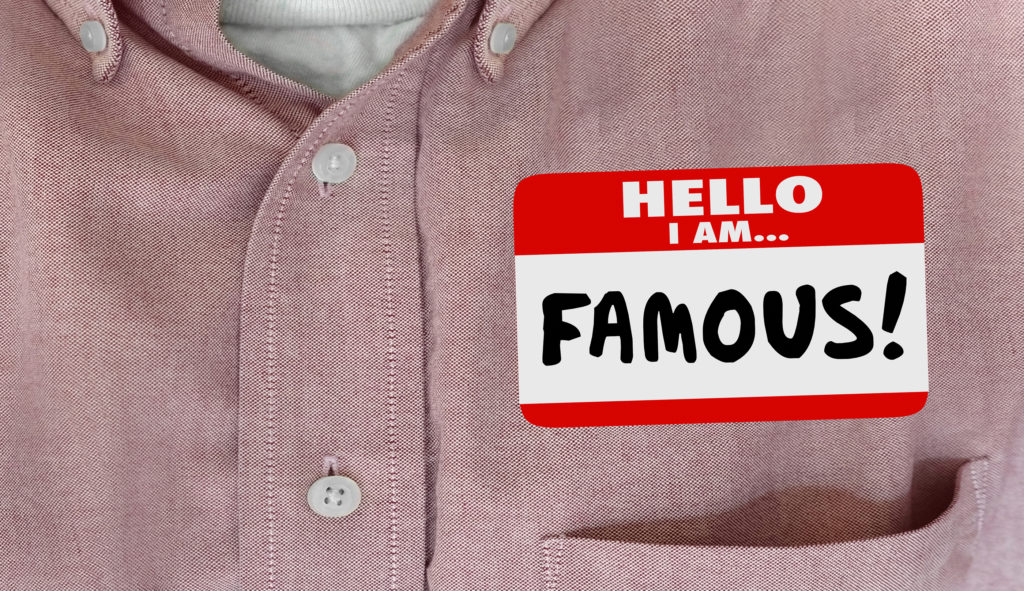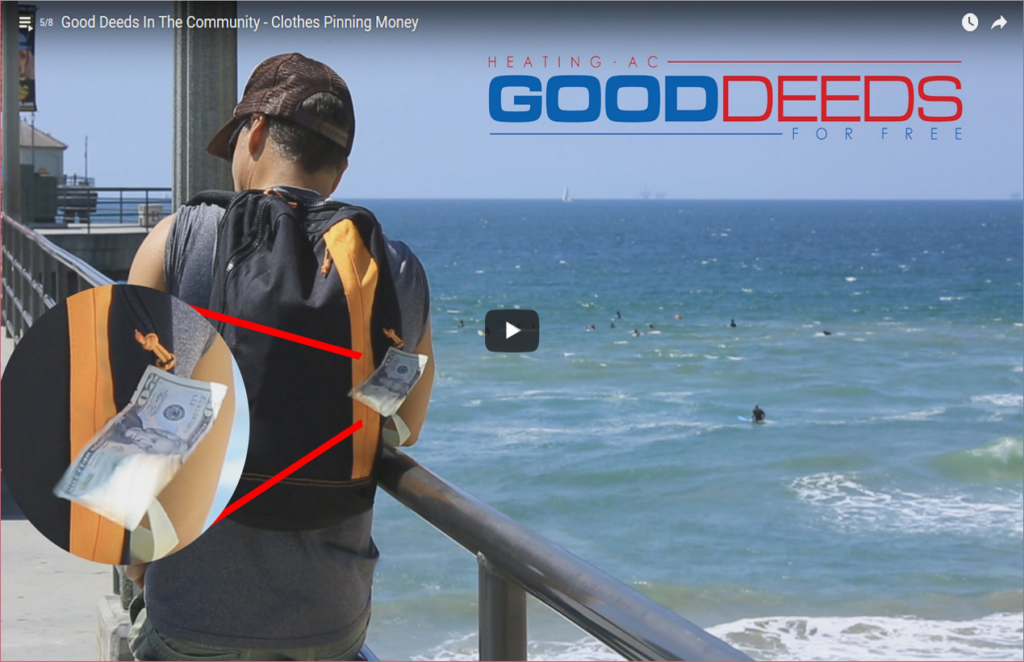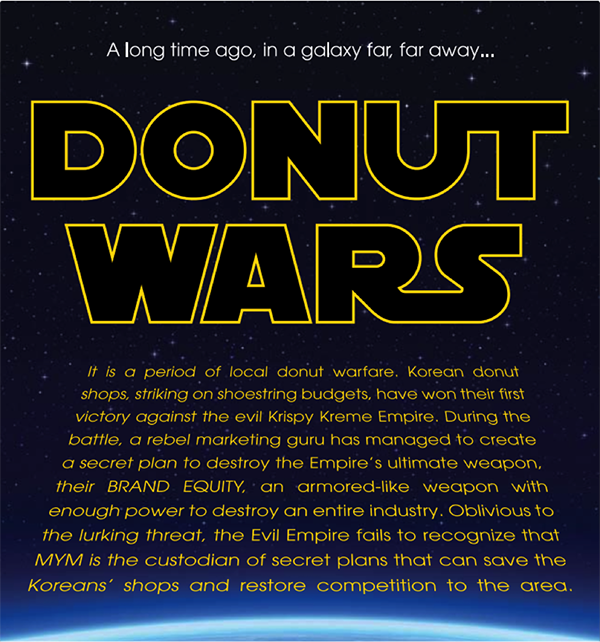Posted by Rich Harshaw on January 6, 2017.

Since we are finishing up the season of giving (but this could be all year long), I want you to think about something.
Something BIG.
Something more important than work.
(Yes, really.)
Here it is…
You can work for yourself, achieve personal goals, and reach your own personal benchmark for success.
But there will come a time when your personal success is no longer enough.
Then, what’s your plan?
For Service Champions, a 30+MM a year HVAC company, the next step is helping others.
A lot.
So much so the company has created the “Good Deeds For Free” program.
Here’s a look at one of their recent Good Deeds—anonymously mailing money to those in need:

Here’s another, in which they help out and donate to a German Shepherd rescue shelter:

And my personal favorite, where they secretly pin money to unaware people on the boardwalk:

I’m not showing you these just for the warm, gooey feelings they give your insides just before the holidays.
I want you to think about what YOU are going to do once you’ve achieved your personal goals for success.
For many people, “paying it forward” is the next step.
Wanting to help others is human nature. And making that happen comes in many forms.
It could be donating to charity. Holding a fundraiser for community schools. Volunteering at the local soup kitchen. Pinning a $20 bill to a stranger’s back.
It could be a thousand and one different things.
Whatever way we choose to give back, one thing is certain: It makes us feel complete. Like we’ve fulfilled our purpose as people.
So when the time comes (and it will come), what will YOU choose to do?
Save
Posted by Rich Harshaw on December 20, 2016.

On an emotional level, your wife’s diamond engagement ring is priceless.
But if we’re talking strictly in terms of money, it’s basically worth bupkis.
In fact, the second you walked out of the jewelers with your wife’s engagement ring—smiling from ear to ear and with your wallet a few thousand dollars lighter—it’s worth immediately plummeted more than two-thirds of what you just paid!
That’s because, contrary to popular belief, diamonds aren’t very valuable.
Diamond sales were actually struggling prior to the 1940s. Before then, giving diamond engagement rings wasn’t even much of a thing.
So, how did diamonds go from worthless hunks of clear carbon to the ultimate (and ultra-expensive) expression of love?
Well, part of it has to do with diamond companies ruthlessly controlling and monopolizing African diamond mines. But that’s another story to be told by someone else. (Try NPR or something.)
I want to focus on another part of what made diamond sales boom in the ‘40s: a slick, social-proof-heavy marketing campaign orchestrated by Da Beers.
Glue your eyeballs to every word of this story because it’s a masterclass in social proof marketing.
In 1938, Da Beers hired N.W. Ayer advertising agency. Within just a few years, N.W. Ayer turned diamonds into a status symbol and an item that you absolutely could NOT do without if you were going to propose to your gal.
For the guy, buying a big ol’ rock to stick on your lady’s finger was a way to measure your success.
For the lady, receiving a big ol’ rock from your man was not only an expression of his love for you, but also a metric for social status. The bigger the diamond, the more “elite” you were.
To get to the point where the public perceived diamonds as 100% mandatory for marriage, N.W. Ayer performed an all-out social proof blitzkrieg.
The agency got movie stars to wear diamonds. Radio hosts to bring in fashion designers to talk about diamonds. Magazines and newspapers to run stories and photos about which celebrities were wearing diamonds.
Everywhere people turned, they ran face-first into stories about how amazing diamonds were and “important people” wearing them.
The campaign worked insanely well. Diamond sales increased 55% in the first three years—smack dab in the middle of the Great Depression!—and the cost of diamonds skyrocketed.
All because of a social proof-heavy marketing campaign.

When everyone is saying diamonds are awesome, it’s hard to disagree.
Today, over 80% of women receive diamond engagement rings when their men propose.
It goes to show that if enough people are eating the pie, everyone else wants a piece.
That’s why online reviews are absolutely crucial for contractors; you cannot and will not thrive without them.
The numbers offer irrefutable proof:
- 9 out of 10 people read online reviews before deciding whether to call a contractor.
- Just a one-star increase on sites like Yelp boost profits 5% to 9%.
- 86% of people hesitate to buy from businesses with negative online reviews.
This all adds up to one thing: You either live or die by your online reputation.
And if you want to live a luxurious life glowing online reviews can provide, MYM Online Reputation Management can help.
Our ORM builds, controls, and maintains a robust online reputation for your company by:
-
Monitoring customer reviews across 170+ review websites
-
Converting happy customers into glowing, sales-producing online reviews
-
Stopping negative reviews BEFORE they happen
-
Turning positive reviews into automated SEO-friendly web and social media content
-
Providing regular comprehensive reporting regarding the “health” and status of your online reputation
Trust me—ORM is as vital to a healthy online reputation as a diamond ring is to a healthy marriage (and a happy wife).
Find out more on the official MYM ORM page.
P.S. You know that whole “spend two months’ salary on a diamond ring” rule of thumb? That was made up by Da Beers, too. After they saw success with a “spend one month’s salary” campaign, they bumped it up to two months. Because, why not?!
Posted by Rich Harshaw on April 9, 2015.
It’s Time To Officially Declare War On Krispy Kreme. This Is Going To Be Tasty.
Now That The Force Of The Brand Is In Place And Customers Have Been Recruited, The Final Blow To The Evil Empire Can Be Dealt…
By Rich Harshaw
Note: This article is part of Monopolize Your Marketplace’s ongoing “Outside The Box” series, which feature ideas, strategies, and case studies from OUTSIDE the remodeling industry, with suggestions of how to implement those ideas into your contractor marketing efforts.
Click here to read Donut Wars, Part 1 before reading below….
Episode 3: The Kill Shot
Please be advised that the following strategy is not for the faint-hearted. It would take tremendous audacity to even attempt it… and unwavering courage to follow through, especially as the opposition toughens up and strikes back. Some of you will read this and say things like “I would never do that” or “that’s totally unprofessional” or “that’s just not very nice.” If that’s you, you are cordially invited to NOT execute this strategy should you ever find yourself as the owner of a local donut shop. You can be the owner of another crummy little store that perpetually gets stomped on and is happy to just eke out a meager existence. Good luck with that.
Our program is called Monopolize Your Marketplace. Monopolize. Think about that for a minute.
The Kill Shot strategy for our little donut shop is to declare war on Krispy Kreme. Not war as in “we are going to do our very best to get as many customers as we can” war. But war as in “we are going to openly declare to the world our official intention to take you down” war.
Sorry, Krispy Kreme. You are now in our crosshairs.
Read More
Posted by Rich Harshaw on April 7, 2015.
Here’s A Story Of A Puny, Rebel Marketing Force That Takes Down An Empire.
A Strategic Plan For A Little Start-Up Donut Shop To Take Down Krispy Kreme.
And Hope For Little Guys Everywhere.
By Rich Harshaw
Note: This article is part of MYM’s ongoing “Outside The Box” series, which feature ideas, strategies, and case studies from OUTSIDE contractor marketing, with suggestions of how to implement those ideas into your business.
Nothing brings joy to a Saturday morning in the Harshaw household more than a couple dozen Krispy Kreme donuts—fresh, hot, and ready to dunk in a cup of cold milk. My six locust-wannabe children can devour two dozen in approximately thirteen seconds—sprinkles and all.
So one Saturday morning when my oldest daughter reminded me she had to be at school for a band competition at 8:30, it was a perfect chance to make a run. My oldest son jumped at the chance to come with me and get the hottest of the hot right after they go through that glaze waterfall thingy. There’s nothing like father-son bonding at 240 calories and eight grams of fat per donut. Homer would be proud.
After we hastily dispatched of the flute player (more for the rest of us!), it was on to donut Shangri La. As we turned right onto Highway 26, my donut radar efficiently picked out a daring new player in the local donut scene. A new shop bearing the generic white letter sign “DONUTS” was a dead giveaway that this was a Korean-owned store. And judging by the parking lot, they weren’t experiencing the typical traffic control problems associated with Krispy Kreme grand openings. In fact, there wasn’t a single car in the lot.
My son was already locked and loaded: “Dad—check it out! A new donut shop! Let’s go there instead of Krispy Kreme. I hate Krispy Kreme. We always go to Krispy Kreme. I like the big donuts from the little shops better.”
The glaze waterfall thingy would have to wait for another day. The Koreans had just won a new customer.
No small feat considering that at approximately three miles from my house, this was the ONLY locally-owned shop in existence. Krispy Kreme had decimated the rest when they opened their mega store three or four years prior.
As we walked in, I was not surprised to see that indeed, this was a Korean shop. “Just opened?” I inquired as I approached the eager employee standing behind the counter ready to serve what appeared to be an endless and yet-untouched supply of donuts. “Three weeks open now,” came the broken-English reply. Amazing—three weeks and already the place had the look and feel of a crusty little donut shop that had been there twenty-five years.
It wasn’t dirty—but there was absolutely nothing remarkable in the entire place. The walls were all painted pale yellow, and on the left wall was the standard-issue donut shop drink cooler with sliding glass doors and an assortment of juices, milks, and energy drinks. Just past the cooler was the huge Jesus picture—the one that’s always there in these kinds of shops, unless they have the more traditional Buddha-type statues. Just below that was the seventeen-year old CD boombox playing random light rock hits from the 80s. The back wall featured a bulletin board where you could leave your business card, which caused me to think—do you really want to hire an accountant, plumber, or personal trainer you found on the bulletin board at the donut shop? A half-dozen of those flimsy little donut shop tables and chairs were in the middle of the shop for those who preferred to dine on their donuts while reading the Korean newspaper that was conveniently available. The glass cases under the counter featured a wide assortment of nice looking donuts—plus those creepy hot dog things wrapped in a bun that I’ve never really seen anyone buy.
Six dollars a dozen was the asking price on the menu board above the clerk’s head—it was the generic kind with lines on it that you can stick letters on to form whatever words and prices you want. Fancies and cream-filled would cost extra—but for regular old donuts, their price was a full dollar less than the Evil Empire was charging less than a mile down the road.
We bought my standard cache—a dozen glazed and a dozen chocolate sprinkles—plus three chocolate milks for the kiddos back home. Then, to my surprise, the lady threw in a dozen donut holes for free—a nice touch. We got out of there for just under seventeen bucks. Not too shabby.
As we drove home I couldn’t help but think that this brave little startup was doomed to be crushed by the venerable Krispy Kreme—it was only a matter of time. But it didn’t have to be this way! A savvy marketing Korean shop could take a substantial chunk out of KK’s hide if they would just employ a few simple strategies. Four strategies to be precise—detailed here for you reading pleasure, so you may be able to use them in your construction, plumber, or HVAC marketing efforts. Think of me as the holographic Princess Leah R2-D2 kept showing Luke in the original Star Wars.
Citizens, we have a plan to destroy the Evil Empire.
Read More















